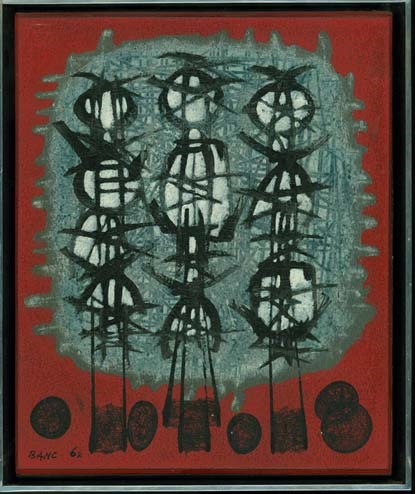
| Print | Back |  |
December 22, 2014 |
 |
Moments in Art Banc-ing on a Joyeux Noelby Lawrence Jeppson |
When I met Jef Banc and began working with him 50 years ago, he gave me a small painting, 9 x 7 ½", India ink and gouache on artists’ heavy paperboard, which he had recently finished. It is signed and dated “Banc/64."
Because I hadn’t yet learned to frame, I turned the framing over to Kulicke Frames in New York City. When the National Gallery of Art, Washington, acquired Leonardo da Vinci’s Ginevra de’ Benci from the Prince of Liechtenstein, the five-million-dollar purchase (peanuts in today’s market) gave them the only da Vinci oil painting in the Western Hemisphere. The National Gallery turned over the reframing to Kulicke. That’s how good these framers were.
In keeping with the painting’s non-traditional depiction, Kulicke welded a stainless steel frame that enabled the painting to float. That is, there is a black gap between the art and the frame.
Jef was a child prodigy. I have written about him before.
When I met Jef, he was struggling for that big breakthrough, although he already had scored some notable achievements. His art was an intense, intuitive, abstract depiction of biological, physical, and psychic beginnings of humanity and matter.
He fought with an artistic integrity and work regime that was without parallel among the many artists I knew. He was approached by a very wealthy man who offered to set Jef up comfortably for life. Jef had only to paint, paint a lot. The catch: all of the art would be signed by the benefactor’s name. There would be no Banc the artist.
That temptation was quickly dismissed.
In France, where educational processes are as rigid as stone, Banc got an unconventional training. At five he was enrolled in a Montessori school emphasizing development of ability and personality. Aptitude tests revealed Jef was far ahead in inventiveness, manual dexterity, and artistic sensitivity.
At 12, Jef received a first place in the competition for the Professional School of the Paris Chamber of Commerce, even though he was three years too young, and was enrolled in the school of the National Porcelain Factory of Sevres. He graduated at 14, when most young men were just entering.
At 17, he set himself up in his own studio. Then the battle really began. He was far from artistic maturity, and the next five years were devoted to exploration and self-teaching. After compulsory military service he was raring to take on the art establishment. Gifted though he was, he was unknown in the art community. He went door to door to call on galleries and collectors for three terrible years before he found a dealer interested in him.
You can read the rest of the “Moments in Art” story and see illustrations of his art in my column “Child Prodigies–Jef Banc,”.
A few weeks ago I received from Paris a huge book depicting Jef’s artistic life and achievement. Wow! It is too big for me to put on my scanners so I can show it to you.
Banc never titled his work. He did not want to give names to abstract work and thus lead viewers away from their own interpretations. So he numbered everything, numbers that indicated the media of the art work as well as the sequential order to their creation.
These numbers were on the back of the art.
Unfortunately, when Kulicke decided to float my work in a stainless steel frame, they mounted the painting within an inner frame and covered up the back in such a way that I cannot see any numbered title Jef may have given it.
However, as owner of the art, I can call it anything I wish.
I call the gem The Three Wise Men.

And with that I wish all my readers and friends, Merry Christmas!
[Next week I will resume my stories of the Monumental Men with a tale about a Monumental Woman.]
| Copyright © 2024 by Lawrence Jeppson | Printed from NauvooTimes.com |